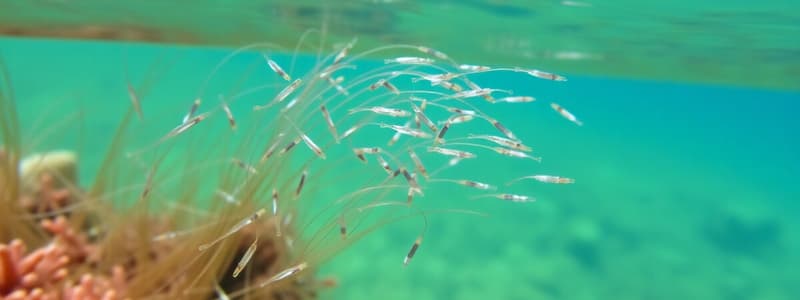Podcast
Questions and Answers
What characterizes the nauplius larva stage in the Chiomass migration?
What characterizes the nauplius larva stage in the Chiomass migration?
- Segmented body with reproductive structures.
- Presence of a distinct dorsal spine.
- Focus on feeding and growth with unsegmented bodies. (correct)
- Engages in mating and reproduction.
Which factor does not increase diatom growth in turbulent waters?
Which factor does not increase diatom growth in turbulent waters?
- Competition from dinoflagellates. (correct)
- Light availability.
- Increased turbulence.
- Nutrient transport.
During what conditions are contact rates between zooplankton and prey highest?
During what conditions are contact rates between zooplankton and prey highest?
- Low prey concentrations during high turbulence. (correct)
- High turbulence with nutrient-depleted surface water.
- Consistent prey availability in nutrient-rich waters.
- High prey concentrations in low turbulence.
What occurs in coastal upwellings during high turbulence events?
What occurs in coastal upwellings during high turbulence events?
How does the nutrient concentration differ between surface and deeper water?
How does the nutrient concentration differ between surface and deeper water?
What does a Reynolds number (Re) of less than 1 indicate about the motion of plankton in water?
What does a Reynolds number (Re) of less than 1 indicate about the motion of plankton in water?
Which of the following statements about plankton locomotion is true due to their environment?
Which of the following statements about plankton locomotion is true due to their environment?
How does the Reynolds number influence the feeding mechanisms of plankton?
How does the Reynolds number influence the feeding mechanisms of plankton?
What is one consequence of the low Reynolds number on energy expenditure for plankton?
What is one consequence of the low Reynolds number on energy expenditure for plankton?
What primarily drives the growth of heterotrophic organisms during the spring in temperate waters?
What primarily drives the growth of heterotrophic organisms during the spring in temperate waters?
In the life cycle of a marine copepod, which stage follows the nauplius stage?
In the life cycle of a marine copepod, which stage follows the nauplius stage?
Which factor most significantly contributes to low primary production during winter in temperate waters?
Which factor most significantly contributes to low primary production during winter in temperate waters?
What occurs during the summer months in temperate waters that impacts primary production?
What occurs during the summer months in temperate waters that impacts primary production?
Which characteristic of the spring bloom directly affects secondary production?
Which characteristic of the spring bloom directly affects secondary production?
During which season are both primary and secondary production at their lowest in temperate waters?
During which season are both primary and secondary production at their lowest in temperate waters?
What occurs during autumn in relation to phytoplankton compared to spring?
What occurs during autumn in relation to phytoplankton compared to spring?
How do tides influence the timing of spring blooms?
How do tides influence the timing of spring blooms?
What is the significance of the chlorophyll maximum (SCM) in stratified waters?
What is the significance of the chlorophyll maximum (SCM) in stratified waters?
What occurs due to nutrient limitations at the surface for phytoplankton?
What occurs due to nutrient limitations at the surface for phytoplankton?
What role do tides play in phytoplankton and diatom interactions?
What role do tides play in phytoplankton and diatom interactions?
What is the primary effect of tidal mixing on the nutrient availability in the photic zone?
What is the primary effect of tidal mixing on the nutrient availability in the photic zone?
Which type of copepod tends to dominate in areas characterized by shallow tidal mixing?
Which type of copepod tends to dominate in areas characterized by shallow tidal mixing?
What role do internal waves play in the distribution of plankton?
What role do internal waves play in the distribution of plankton?
What is a significant consequence of persistent tidal mixing, as seen in Georges Bank?
What is a significant consequence of persistent tidal mixing, as seen in Georges Bank?
What typically happens to zooplankton populations in thermally stratified waters?
What typically happens to zooplankton populations in thermally stratified waters?
What role do tidal fronts play in marine ecosystems?
What role do tidal fronts play in marine ecosystems?
How do internal waves affect plankton populations in marine environments?
How do internal waves affect plankton populations in marine environments?
What is a significant consequence of tidal island waves in coastal ecosystems?
What is a significant consequence of tidal island waves in coastal ecosystems?
In what way do tidal fronts support growth and recruitment in nursery areas?
In what way do tidal fronts support growth and recruitment in nursery areas?
What has been observed regarding the nutrient-rich waters in Florida Bay?
What has been observed regarding the nutrient-rich waters in Florida Bay?
Flashcards
Reynolds Number (Re)
Reynolds Number (Re)
A dimensionless number used to characterize the flow of a fluid around an object. It is calculated by dividing inertial forces by viscous forces.
Plankton and Low Reynolds Number
Plankton and Low Reynolds Number
Plankton experience a very low Reynolds number, meaning viscous forces dominate their movement. Imagine moving through honey; this is what it feels like for them!
Locomotion in Low Re
Locomotion in Low Re
In low Reynolds number environments, organisms must use constant but low-power movements, like beating cilia, to move
Feeding Mechanisms in Low Re
Feeding Mechanisms in Low Re
Signup and view all the flashcards
Marine Copepod Life Cycle
Marine Copepod Life Cycle
Signup and view all the flashcards
Nauplius Larva
Nauplius Larva
Signup and view all the flashcards
Copepodite Stage
Copepodite Stage
Signup and view all the flashcards
Turbulence in the Ocean
Turbulence in the Ocean
Signup and view all the flashcards
Turbulence and Plankton Prey Interactions
Turbulence and Plankton Prey Interactions
Signup and view all the flashcards
Turbulence and Foraging
Turbulence and Foraging
Signup and view all the flashcards
What is primary production?
What is primary production?
Signup and view all the flashcards
What is secondary production?
What is secondary production?
Signup and view all the flashcards
Why is primary production low in winter?
Why is primary production low in winter?
Signup and view all the flashcards
Why is there a spring bloom?
Why is there a spring bloom?
Signup and view all the flashcards
Why does primary production decline in summer?
Why does primary production decline in summer?
Signup and view all the flashcards
Stratification Breakdown
Stratification Breakdown
Signup and view all the flashcards
Autumn Phytoplankton Bloom
Autumn Phytoplankton Bloom
Signup and view all the flashcards
Tides and Primary Production
Tides and Primary Production
Signup and view all the flashcards
Tide Influence on Spring Blooms
Tide Influence on Spring Blooms
Signup and view all the flashcards
Chlorophyll Maximum (SCM)
Chlorophyll Maximum (SCM)
Signup and view all the flashcards
Thermocline
Thermocline
Signup and view all the flashcards
Nutrient Upwelling
Nutrient Upwelling
Signup and view all the flashcards
Photosynthesis at the Thermocline
Photosynthesis at the Thermocline
Signup and view all the flashcards
Tidal Mixing and Nutrient Transport
Tidal Mixing and Nutrient Transport
Signup and view all the flashcards
Internal Waves and Plankton Distribution
Internal Waves and Plankton Distribution
Signup and view all the flashcards
What impact do internal waves have on phytoplankton?
What impact do internal waves have on phytoplankton?
Signup and view all the flashcards
How do internal waves influence zooplankton populations?
How do internal waves influence zooplankton populations?
Signup and view all the flashcards
What makes tidal fronts important habitats?
What makes tidal fronts important habitats?
Signup and view all the flashcards
What is the link between tidal fronts and nutrient mixing?
What is the link between tidal fronts and nutrient mixing?
Signup and view all the flashcards
How does the tidal cycle influence estuarine productivity (Chesapeake Bay)?
How does the tidal cycle influence estuarine productivity (Chesapeake Bay)?
Signup and view all the flashcards




